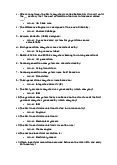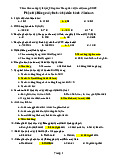


Preview text:
1) o
Computer application (app): a computer software program that
executes on a computing device to carry out a specific set of functions. o
Information system: a set of interrelated components that collects,
processes, stores, and provides as output the information needed to complete business tasks.
2) Systems analysis is conducted for the purpose of studying a system or
its parts in orders to identify its objectives. It is a problem solving
technique that improves the system and ensures that all the
components of the system work efficiently to accomplish their purpose. 3) -
Systems analysis: those activities that enable a person to
understand and specify what an information system should accomplish. -
System design: those activities that enable a person to define and
describe in detail the system that solves the need.
4) Project: a planned undertaking that has a beginning and end that produces some definite result -
Used to develop an information system -
Requires knowledge of systems analysis and systems design tools and techniques.
5) Systems development process: the actual approach used to develop a particular information system - Unified process (UP) - Extreme programming (XP) - Scrum 6) -
Identify the problem and obtain approval - Plan and monitor the project -
Discover and understand details - Design system components -
Build, test, and integrate system components -
Complete the system tests and deploy the solution 7) -
Agile development: an information system development process
that emphasizes flexibility tp anticipate new requirements during development -
Iterative development: an approach to system development in
which the system is “grown” piece by piece through multiple iterations
8) A system vision document is a comprehensive outline that defines the
goals, objectives, and requirements of a particular system or project. It
serves as a roadmap for the development and implementation of the
system, providing a clear direction and purpose for all stakeholders involved
9) A system is a collection of organized things and combination of parts
working together to accomplish a goal. Whereas a subsystem is
derived from system and it is an integral part of a larger system 10) -
Discover and understand the details of all aspects of the problem -
Design the components of the solution to the problem -
Build the components and integrate everything into the solution -
Perform all system-level test and the deploy the solution 11)
WBS is a project management tool that takes a step-by-step
approach to complete large project with several moving pieces. 12)
Describe the high-level functions and scope of a system 13)
An overview of the target system by describing the objects and
classes inside the system and the relationships between them 14)
The use case diagram defines the processes of the new system
and the class diagram defines the data of the new system 15)
Activity diagram is basically a flowchart to represent the flow
from one activity to another activity. The activity can be described as an operation of the system. 16)
Describe the steps performed in a UML use case. 17)
The component-based architecture focuses on breaking the
software design into small individual modules. 18)
A design class diagram is an extension of a class diagram and its
shows how the attributes become data fields with type information 19) 20)
The goal of UAT to ensure software can handle real-world task
and perform up to development specifications 21)
Allow the project to be partitioned into smaller chunks of work
that can be managed and controlled better
22) To produce a portion of the solution system




